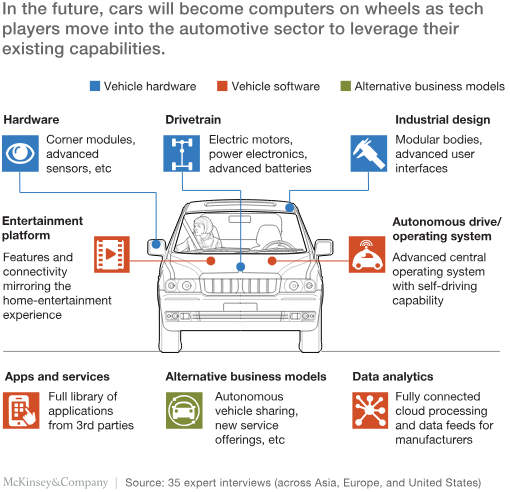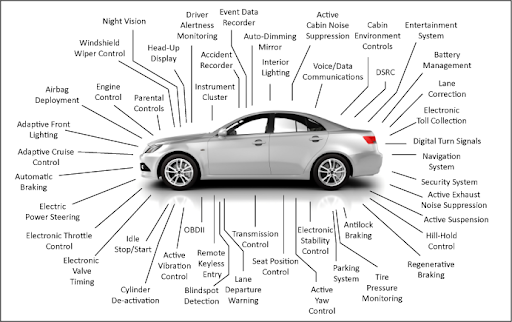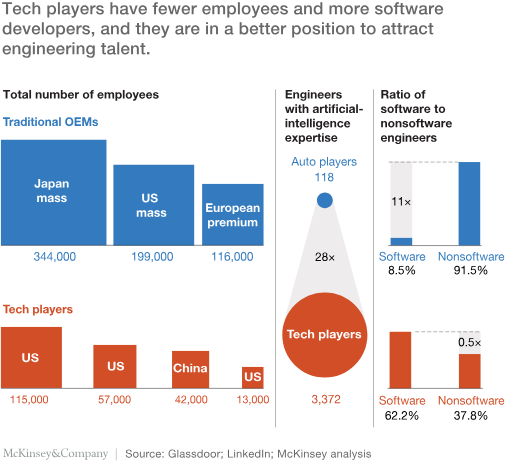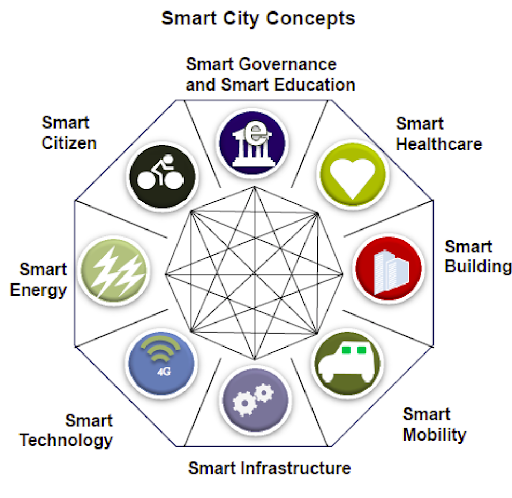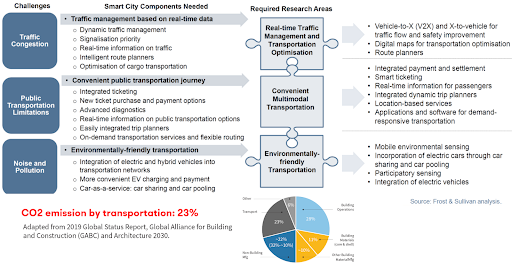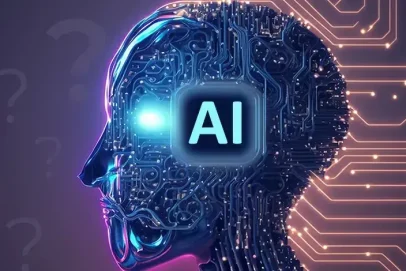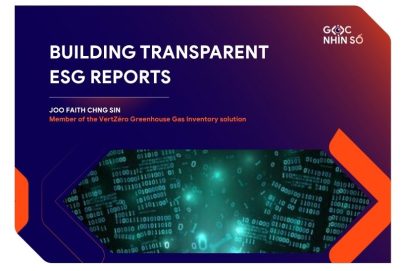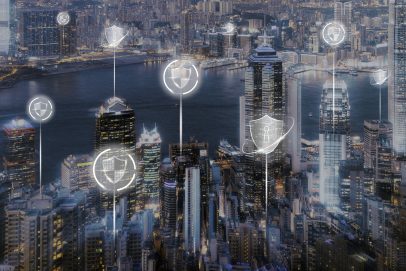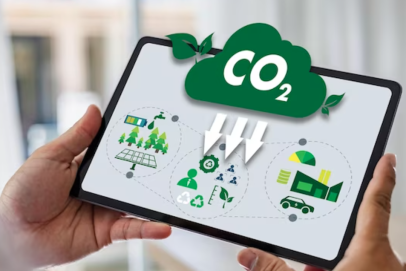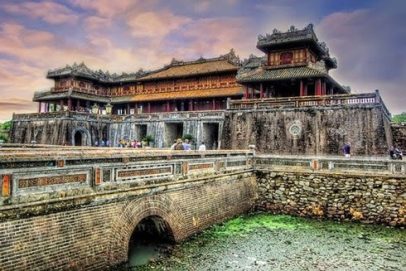Convergence of Automotive and Technology in Smart Transportation Industry
In the modern technological era, the automotive industry is undergoing a dramatic transformation driven by various technologies and converging with smart transportation/mobility to address complex problems as well as cater for people’s increasing demands in terms of economics, society, and environment. The growth of autonomous vehicle systems is making transportation both safer and more efficient. These advanced technologies are reshaping the way we move, opening up a new era for smart and sustainable transportation with numerous great opportunities for the participation, cooperation, and the leadership of Vietnamese tech companies.
1. Trends for a new ecosystem of the automotive industry and opportunities
According to reports by McKinsey and others, the convergence of technology and the automotive industry with change-driving trends will create a new ecosystem with new rules for success:
- Electrification will shift toward hybrid-electric, electric, and fuel-cell vehicles (HEV/EV/FC).
- Autonomous driving will move from advanced driver-assistance systems to fully autonomous driving.
- Diverse mobility will evolve to mobility-as-a-service, including car purchase, lease, rentals, and sharing.
- Connectivity: The possibilities for “infotainment” innovations, novel traffic services, and new business models and services will increase as cars get connected to each other, to the wider infrastructure, and to people.
- In addition, from my personal perspective, Sustainable Development Goals (SDG) and Environmental, Social, and Governance (ESG) will also drive change in the automotive industry.
Modern cars today have more than 50 separate computer systems performing different functions. Future cars will become a more complex system with numerous computers, systems, software, and networks on-wheels connecting with people and other systems. This leads to the need to develop software for vehicle systems and applications, the value chain/supply chain of the automotive industry, and various ground, air, and above/under water motor vehicles.
Many tech-players have jumped into this area with a much higher ROIC compared to traditional auto-players (34.1% compared to 6.6% in the US). Tech-players’ total workforce numbers are only about 1/3 of that of auto-players while their software engineers account for 62.2% of their total employees. This opens up opportunities for technology and software companies.
The opportunities for tech-players in Vietnam, in my opinion, could be:
- Develop software for about 2-3 standard operating systems for auto-driving.
- Develop software for about 2-3 in-car-entertainment-ecosystems.
- Provide big-data-driven services, software development, cloud and analytics services for commercialization and customer experience enhancement.
- Develop application software and services for consumers in vehicle use and other processes that outperform previously built-in vehicle applications.
Apart from the automotive industry, the transition to electric, autonomous, and autonomous-guided vehicles offered by AutoTech unlocks opportunities for Vietnamese technology companies to co-create digital and green transformations in diverse industries in Vietnam:
- EV/AV/AGV in smart agriculture
- EV/AV/AGV in smart urban transportation
- EV/AV/AGV in logistics (warehouses, ports, urban areas)
- Mobility-as-a-service platform/provider (which has been adopted by some automotive distribution companies).
2. Sustainable smart transportation needs to align with the development of the automobile and transportation industry for efficiency improvement
Another point of convergence is smart transportation in smart cities. Smart cities have been introduced and developed in Vietnam since the late 1990s, also known as smart cities 1.0. The evolvement to smart cities 2.0 occurred in 2005, and the 3.0 era started in 2010, focusing on both “hardware” (ICT technology) and “software” (society, people, participation, and urban planning). Currently, challenges are facing the development of smart cities in Vietnam due to insufficient effort expended in the first two eras. These hurdles encompass the lack of guidelines, models, and standards for a comprehensive approach to smart cities, limited awareness of stakeholders in data sharing, fragmented investment, and others. There are, on the other hand, bright spots in the overall picture of smart city development in the country such as Da Nang, Quang Ninh, Binh Dinh, some other provinces, and especially Ho Chi Minh City.
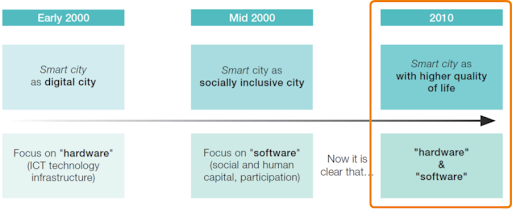
In a more specific view of Frost & Sullivan, smart cities are cities/municipalities that implement a comprehensive, unified development strategy based on smart technologies and solutions with 5 to 8 components:
- Smart citizen
- Smart energy
- Smart healthcare
- Smart building
- Smart mobility/transportation
- Smart infrastructure
- Smart technology
- Smart governance and smart education
Smart Transportation or Smart Mobility is crucial for the economic and social development, as well as environmental preservation of urban areas in particular and a country in general.
Also, according to Frost & Sullivan, urbanization and economic and social development have created and accumulated major problems that smart transportation needs to solve or be involved in solving:
- Traffic congestion
- Limitations of the transportation system
- Pollution caused by traffic
This requires vehicles to be equipped with new capabilities, and one of them is smart, or being able to connect to the infrastructure/system (V2X) to improve traffic conditions, road user safety and experience, as well as protect the environment. The rapid development of autotech has mass released numerous new car models that come with smart features, including V2V (vehicle-to-vehicle), V2F (vehicle-to-field/infrastructure), etc., communications. This new generation of automobiles aims to join forces with the traffic infrastructure and traffic management systems to tackle problems faced by smart transportation and enhance road user experience. However, this growth among car brands/models, among commercial vehicles for personal use and for commercial transportation (trucks, specialized vehicles) and public transportation (urban buses, trains…), and among vehicles and urban infrastructure, urban/national traffic management and operation systems, is not aligned.
When we put EV/AV/AGV in the context of agriculture and logistics industries, for example, the same misalignment is formed between service expectations and vehicle and system capabilities. This poses a series of challenges from planning, design, implementation, operation, and business models that Vietnamese tech-players can join to address:
- Traffic/Smart Mobility (including passengers and goods; rail, air and water transport)
- Smart Agriculture
- Smart Logistics and Smart Supply Chain Management
Each of these bottlenecks requires the inevitable presence of traditional, foundational technologies of the industry combined with capabilities of new technologies such as AI, IoT, Big Data, Security, new materials, Robotics, Digital Twin, Semiconductors, etc., and of course, software, a frequent participant. This convergence will maximize the newly developed capabilities of smart cars/vehicles when being used with or integrated into transportation systems, bringing seamless transportation/mobility experience as well as contributing to economic and social development and environmental preservation. Technology, however, is not the only factor that makes this happen. It’s the synergy of overall planning, design, inter-system/inter-sectoral integration, and a synchronized roadmap for problem-solving as a whole, as well as in each system and situation.
| Exclusive article by FPT IS Business Technology ExpertsAuthor Phan Thanh Son – Business Development Director, FPT IS |


